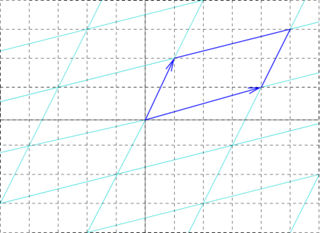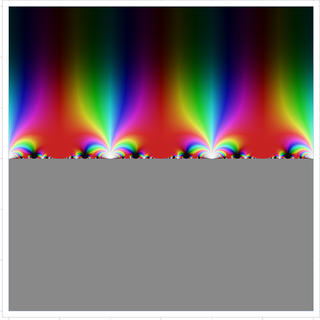In mathematics, a modular form is a (complex) analytic function on the upper half-plane, , that roughly satisfies a functional equation with respect to the group action of the modular group and a growth condition. The theory of modular forms has origins in complex analysis, with important connections with number theory. Modular forms also appear in other areas, such as algebraic topology, sphere packing, and string theory.

In mathematics, the Weierstrass elliptic functions are elliptic functions that take a particularly simple form. They are named for Karl Weierstrass. This class of functions are also referred to as ℘-functions and they are usually denoted by the symbol ℘, a uniquely fancy script p. They play an important role in the theory of elliptic functions, i.e., meromorphic functions that are doubly periodic. A ℘-function together with its derivative can be used to parameterize elliptic curves and they generate the field of elliptic functions with respect to a given period lattice.

In mathematics, theta functions are special functions of several complex variables. They show up in many topics, including Abelian varieties, moduli spaces, quadratic forms, and solitons. Theta functions are parametrized by points in a tube domain inside a complex Lagrangian Grassmannian, namely the Siegel upper half space.

In mathematics, Felix Klein's j-invariant or j function, regarded as a function of a complex variable τ, is a modular function of weight zero for special linear group SL(2, Z) defined on the upper half-plane of complex numbers. It is the unique such function that is holomorphic away from a simple pole at the cusp such that
In mathematics, the Poisson summation formula is an equation that relates the Fourier series coefficients of the periodic summation of a function to values of the function's continuous Fourier transform. Consequently, the periodic summation of a function is completely defined by discrete samples of the original function's Fourier transform. And conversely, the periodic summation of a function's Fourier transform is completely defined by discrete samples of the original function. The Poisson summation formula was discovered by Siméon Denis Poisson and is sometimes called Poisson resummation.
The representation theory of groups is a part of mathematics which examines how groups act on given structures.
Variational Bayesian methods are a family of techniques for approximating intractable integrals arising in Bayesian inference and machine learning. They are typically used in complex statistical models consisting of observed variables as well as unknown parameters and latent variables, with various sorts of relationships among the three types of random variables, as might be described by a graphical model. As typical in Bayesian inference, the parameters and latent variables are grouped together as "unobserved variables". Variational Bayesian methods are primarily used for two purposes:
- To provide an analytical approximation to the posterior probability of the unobserved variables, in order to do statistical inference over these variables.
- To derive a lower bound for the marginal likelihood of the observed data. This is typically used for performing model selection, the general idea being that a higher marginal likelihood for a given model indicates a better fit of the data by that model and hence a greater probability that the model in question was the one that generated the data.

In nuclear physics, the chiral model, introduced by Feza Gürsey in 1960, is a phenomenological model describing effective interactions of mesons in the chiral limit (where the masses of the quarks go to zero), but without necessarily mentioning quarks at all. It is a nonlinear sigma model with the principal homogeneous space of a Lie group as its target manifold. When the model was originally introduced, this Lie group was the SU(N), where N is the number of quark flavors. The Riemannian metric of the target manifold is given by a positive constant multiplied by the Killing form acting upon the Maurer–Cartan form of SU(N).

In mathematics, a fundamental pair of periods is an ordered pair of complex numbers that defines a lattice in the complex plane. This type of lattice is the underlying object with which elliptic functions and modular forms are defined.

In mathematics, a quasiperiodic function is a function that has a certain similarity to a periodic function. A function is quasiperiodic with quasiperiod if , where is a "simpler" function than . What it means to be "simpler" is vague.

In mathematics, a complex torus is a particular kind of complex manifold M whose underlying smooth manifold is a torus in the usual sense. Here N must be the even number 2n, where n is the complex dimension of M.

The Rogers–Ramanujan continued fraction is a continued fraction discovered by Rogers (1894) and independently by Srinivasa Ramanujan, and closely related to the Rogers–Ramanujan identities. It can be evaluated explicitly for a broad class of values of its argument.
In mathematics, a Jacobi form is an automorphic form on the Jacobi group, which is the semidirect product of the symplectic group Sp(n;R) and the Heisenberg group . The theory was first systematically studied by Eichler & Zagier (1985).

The contrast transfer function (CTF) mathematically describes how aberrations in a transmission electron microscope (TEM) modify the image of a sample. This contrast transfer function (CTF) sets the resolution of high-resolution transmission electron microscopy (HRTEM), also known as phase contrast TEM.
Quantum characteristics are phase-space trajectories that arise in the phase space formulation of quantum mechanics through the Wigner transform of Heisenberg operators of canonical coordinates and momenta. These trajectories obey the Hamilton equations in quantum form and play the role of characteristics in terms of which time-dependent Weyl's symbols of quantum operators can be expressed. In the classical limit, quantum characteristics reduce to classical trajectories. The knowledge of quantum characteristics is equivalent to the knowledge of quantum dynamics.

In mathematics, the modular lambda function λ(τ) is a highly symmetric Holomorphic function on the complex upper half-plane. It is invariant under the fractional linear action of the congruence group Γ(2), and generates the function field of the corresponding quotient, i.e., it is a Hauptmodul for the modular curve X(2). Over any point τ, its value can be described as a cross ratio of the branch points of a ramified double cover of the projective line by the elliptic curve , where the map is defined as the quotient by the [−1] involution.
In mathematics, the oscillator representation is a projective unitary representation of the symplectic group, first investigated by Irving Segal, David Shale, and André Weil. A natural extension of the representation leads to a semigroup of contraction operators, introduced as the oscillator semigroup by Roger Howe in 1988. The semigroup had previously been studied by other mathematicians and physicists, most notably Felix Berezin in the 1960s. The simplest example in one dimension is given by SU(1,1). It acts as Möbius transformations on the extended complex plane, leaving the unit circle invariant. In that case the oscillator representation is a unitary representation of a double cover of SU(1,1) and the oscillator semigroup corresponds to a representation by contraction operators of the semigroup in SL(2,C) corresponding to Möbius transformations that take the unit disk into itself.
In mathematics, the Weil–Brezin map, named after André Weil and Jonathan Brezin, is a unitary transformation that maps a Schwartz function on the real line to a smooth function on the Heisenberg manifold. The Weil–Brezin map gives a geometric interpretation of the Fourier transform, the Plancherel theorem and the Poisson summation formula. The image of Gaussian functions under the Weil–Brezin map are nil-theta functions, which are related to theta functions. The Weil–Brezin map is sometimes referred to as the Zak transform, which is widely applied in the field of physics and signal processing; however, the Weil–Brezin Map is defined via Heisenberg group geometrically, whereas there is no direct geometric or group theoretic interpretation from the Zak transform.
Tau functions are an important ingredient in the modern mathematical theory of integrable systems, and have numerous applications in a variety of other domains. They were originally introduced by Ryogo Hirota in his direct method approach to soliton equations, based on expressing them in an equivalent bilinear form.
In theoretical physics, more specifically in quantum field theory and supersymmetry, supersymmetric Yang–Mills, also known as super Yang–Mills and abbreviated to SYM, is a supersymmetric generalization of Yang–Mills theory, which is a gauge theory that plays an important part in the mathematical formulation of forces in particle physics. It is a special case of 4D N = 1 global supersymmetry.










































